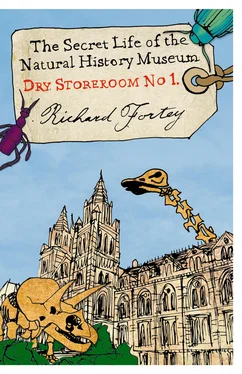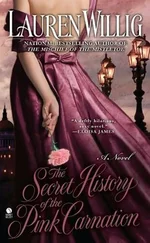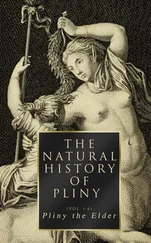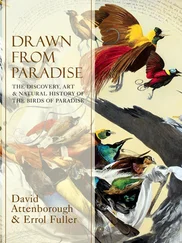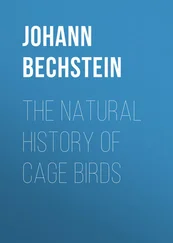So there I was in my official premises, surrounded by the collections upon which I was to work and to which I was supposed to add. My contract had specified only that I ‘should undertake work upon the fossil Arthropoda’, which left me free to roam through hundreds of millions of years. It might as well have said: ‘Amuse yourself – for money.’ But I did have a boss to whom I was accountable. As I have mentioned, the head of department in a British national museum is called the Keeper. This may call up an image of a man in braces mucking out a gorilla cage, or it may have connotations of somebody jangling keys and going around inspecting security locks. It is, however, rather a grand title, one that entitles the bearer to an entry in Who’s Who . My boss, the Keeper of Palaeontology, was H. W. Ball – Harold William. Above a certain level in the hierarchy one was allowed to call him ‘Bill’; otherwise, it was always ‘Dr Ball’. He had the room directly above me, a place of leather-topped desks and filing cabinets. He was guarded by the kind of devoted secretary who exists mostly in the pages of spy novels, like the prim Miss Moneypenny in the James Bond thrillers. She was called Miss Belcher. She was an unmarried lady who lived with and cared for her mother; in the Palaeontology Department she was omniscient. Some years later, I discovered that her Christian name was Phoebe, but I would have no more dreamed of addressing her by that name than I would of addressing the Queen as ‘Lizzie’. She occupied an anteroom through which one had to pass to access the presence of the Keeper; and she always called him that, just as she always called me ‘Dr Fortey’ until she retired. She regarded such access as a rare and precious commodity, and an audience was a privilege to be awarded reluctantly. In fact, one usually went to see the Keeper because one was summoned. Few employees dropped in for a chinwag.
Occasionally, the summons was for doing something naughty. It was easy to anticipate these occasions. Normally, Dr Ball gestured towards a chair, beaming, and said something like: ‘Sit ye down, dear boy.’ He had a slightly polished-up, satisfied air, like the head boy of a posh school. On the other hand, if you had transgressed one of the rules, you earned a particular stare that P. G. Wodehouse described as ‘basilisk’ when emanating from one of Bertie Wooster’s more terrifying aunts. Once I was ticked off for the key offence – leaving them displayed to the world upon my desk. Then there was a diary infringement. The diary was a hangover from the early days of the Museum, being a little book into which the employee was supposed to write his activities, morning and afternoon, and which was collected every month and signed off by the head of department. It was a very tedious bit of bureaucracy, and nobody on the shop floor took it seriously. I took to writing ‘study trilobites’ on the first day of the month and ditto marks for the rest of it. Miss Belcher called me up to say that the Keeper didn’t regard this as adequate, and would I please put in more details. So the following month I put in entries like ‘a.m. open envelopes’ and ‘p.m. post replies’ and at the end of the month: ‘p.m. write diary’. My attempts at humour were not appreciated upstairs. The Keeper gave me a flea in my ear and sent me on my way, remarking that nobody was indispensable. Such encounters were, fortunately, infrequent. Diaries were abolished after a few years, and nobody mourned their loss, not even Miss Belcher. The concept of accountability was fairly rudimentary then, so a more usual meeting was an interview once a year with the Keeper to check on my progress. After the ‘sit ye down’ invitation this grilling usually consisted of noting that I had finished one or two publications that year, jolly good, and see you next year. I had to report on my curatorial assistant, Sam Morris, in similar terms.
Once I was settled into the Museum I vowed to explore the five science departments: Palaeontology, Mineralogy, Zoology, Botany and, in some distant redoubt, Entomology. The hidden museum seemed to stretch in every direction. As more and more new corners were discovered there seemed no end to it. The public galleries were flanked, underlain and overlain by hidden rooms and galleries and laboratories. There were separate wings and towers. There were odd blind alleys, others that opened into another unsuspected gallery. Some corridors were narrow and poorly lit, and suddenly took a turn downwards into flights of stairs. Others were wider, lined on both sides by mahogany doors carrying the names and titles of the researchers who hid behind them: Dr J. D. Taylor, Mr F. Naggs and Miss K. Way were just down the way from my office in the basement. Most of the names were to be matched with faces over the coming months. There were a few I never met face to face. Down here in the vaults, there is none of the grand decoration of the public galleries; plain slab floors are the rule, pipes and cable housing run here and there, and almost everything is smothered in institutional cream paintwork. On all sides there are locked cabinets bearing tantalizing labels: Blattidae; Lucinidae; Phyllograptidae. What could they all mean?
Outside my office loomed stuffed elephants and giraffes covered in tarpaulins, dead exhibits that had once graced the main hall. They were now slightly down-at-heel and neglected, with a few bald bits, and rather sad, like a disused sideshow at a fair. The corridors were sealed off into sections by doors that could be opened using the magic keys. It is said that rats, when learning a new maze, make short dashes from home base to start with, gradually extending their range so that unfamiliar territory becomes familiar. So it was with my exploration of the underground or behind-the-wall labyrinth of the Museum. I was able to probe my way from my office in several directions, and I could usually find my way back again. If I got lost, I could pop out of one of the doors into the nearest public gallery to locate my position. Gradually, the most arcane corners of the Museum yielded their secrets.
Westwards along the basement, I let myself through a heavy door just beyond the dead giraffes. There was a notice on the wall that read ‘Departmental cock’ – I never did find out what that meant. Beyond the door, a corridor stretched away lined with polished cabinets on both sides. I had left the Palaeontology Department and entered Zoology. The cabinets housed shells; thousands upon thousands of shells. This was the mollusc section of the Zoology Department, a place where the lingua franca was shells. The cupboard labelled Lucinidae was just one family among many of clams. Any drawer in the stack housed a dozen different species belonging to that family which might come from anywhere in the world, packets of shells laid out neatly in labelled boxes. Many of us have made desultory collections of shells while pottering on the beach on summer holidays: these collections were like an almost infinite and systematic multiplication of that brief acquisitiveness. Dr J. D. Taylor and his colleagues occupied the offices whose doors opened between the cabinets. Like my own office, they had windows facing out on to the lawns in front of the Museum, and their offices, too, were lined with collections and books, which gave them a cosy, nest-like quality. I soon got to know John Taylor, Fred Naggs and Kathy Way as the mollusc people, the conchology gang, at home with gastropods and bivalves, squids and slugs, nudibranchs and pteropods. As I write this, they are still working in the same rooms, tucked away in their basement redoubt, John Taylor labouring on his beloved molluscs long after most of his contemporaries have taken to the golf club or the allotment. Downstairs from John Taylor’s room there was a collection of octopuses and other soft-bodied animals stored in jars, pickled in alcohol and formalin, dead things all pallid and covered in suckers, slightly threatening, as if they might creep out of their accommodation when no one was looking.
Читать дальше
